Name Dannebrog Proportion 56:107 Adopted on 15 June 1219 | Proportion 28:34 to 28:37 Country Denmark | |
 | ||
Design A red field charged with a white cross extending to the edges; the vertical part of the cross is shifted to the hoist side. Dimensions: 3:1:3 width / 3:1:4.5 to 3:1:5.25 length. | ||
Danebrog the flag of denmark
The Flag of Denmark (Danish: Dannebrog [ˈdanəˌbʁoˀ]) is red with a white Scandinavian cross that extends to the edges of the flag; the vertical part of the cross is shifted to the hoist side.
Contents
- Danebrog the flag of denmark
- Flag of denmark
- Description
- Middle Ages
- Early military banners
- Maritime flags
- National flag
- Origin legend
- Splitflag and Orlogsflag
- Royal Standards
- Other flags of the Kingdom of Denmark
- Regional Flags
- References
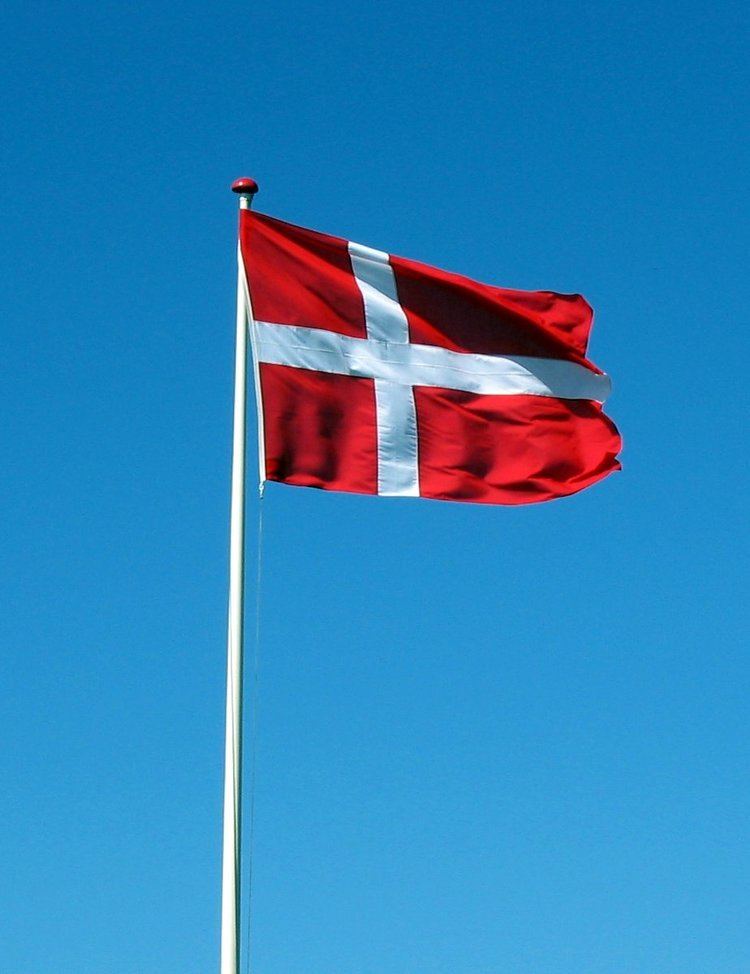
A banner with a white-on-red cross is attested as having been used by the kings of Denmark since the 14th century. An origin legend with considerable impact on Danish national historiography connects the introduction of the flag to the Battle of Lyndanisse of 1219. The elongated Nordic cross reflects the use as maritime flag in the 18th century. The flag became popular as national flag in the early 19th century. Its private use was outlawed in 1834, and again permitted in a regulation of 1854. The flag holds the world record of being the oldest continuously used national flag.
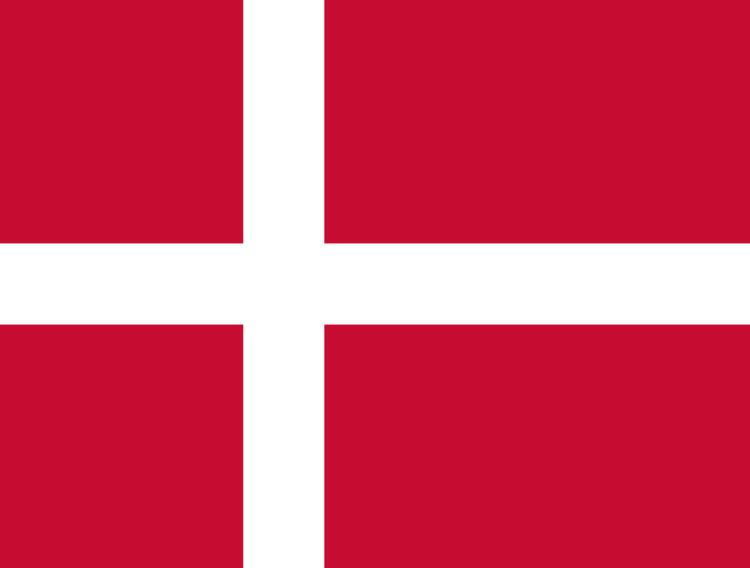
Flag of denmark
Description
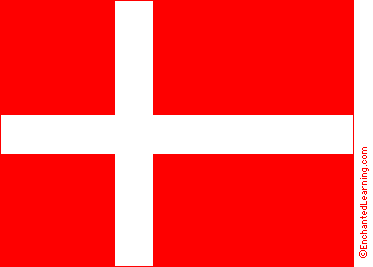
A red field charged with a white cross extending to the edges; the vertical part of the cross is shifted to the hoist side. In 1748, a regulation defined the correct lengths of the two last fields in the flag as 6⁄4. In May 1893 a new regulation to all chiefs of police, stated that the police should not intervene, if the two last fields in the flag were longer than 6⁄4 as long as these did not exceed 7⁄4, and provided that this was the only rule violated. This regulation is still in effect today and thus the legal proportions of the National flag is today 3:1:3 in width and anywhere between 3:1:4.5 and 3:1:5.25 in length.
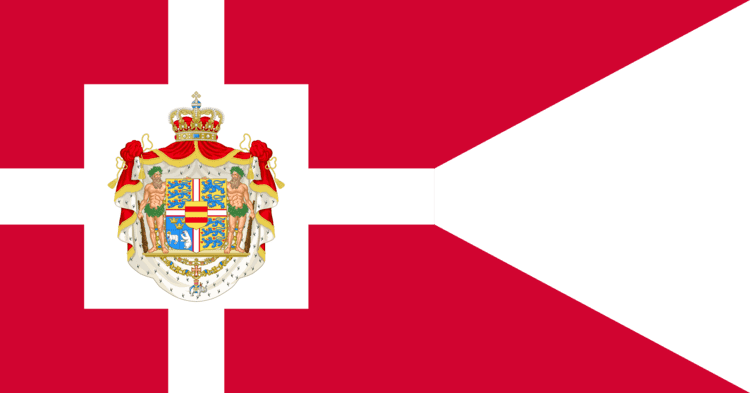
No official nuance definition of "Dannebrog rød" exists. The private company Dansk Standard, regulation number 359 (2005), defines the red colour of the flag as Pantone 186c.
Middle Ages

The white-on-red cross emblem originates in the age of the Crusades. In the 12th century, it was also used as war flag by the Holy Roman Empire.
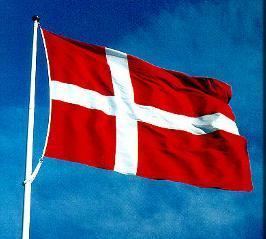
In the Gelre Armorial, dated c. 1340–1370, such a banner is shown alongside the coat of arms of the king of Denmark. (The King of Denmark). This is the earliest known undisputed colour rendering of the Dannebrog. At about the same time, Valdemar IV of Denmark displays a cross in his coat of arms on his Danælog seal (Rettertingsseglet, dated 1356). The image from the Armorial Gelre is nearly identical to an image found in a 15th-century coats of arms book now located in the National Archives of Sweden, (Riksarkivet) The seal of Eric of Pomerania (1398) as king of the Kalmar union displays the arms of Denmark chief dexter, three lions. In this version, the lions are holding a Danebrog banner.
The reason why the kings of Denmark in the 14th century begin displaying the cross banner in their coats of arms is unknown. Caspar Paludan-Müller (1873) suggested that it may reflect a banner sent by the pope to the Danish king in support of the Baltic countries. Adolf Ditlev Jørgensen (1875) identifies the banner as that of the Knights Hospitaller, which order had a presence in Denmark from the later 12th century.
Several coins, seals and images exist, both foreign and domestic, from the 13th to 15th centuries and even earlier, showing heraldic designs similar to Dannebrog, alongside the royal coat of arms (three blue lions on a golden shield.)
Early military banners
There is a record suggesting that the Danish army had a "chief banner" (hoffuitbanner) in the early 16th century. Such a banner is mentioned in 1570 by Niels Hemmingsøn in the context of a 1520 battle between Danes and Swedes near Uppsala as nearly captured by the Swedes but saved by the heroic actions of the banner-carrier Mogens Gyldenstierne and Peder Skram. The legend attributing the miraculous origin of the flag to the campaigns of Valdemar II of Denmark (r. 1202–1241) were recorded by Christiern Pedersen and Petrus Olai in the 1520s.
Hans Svaning's History of King Hans from 1558–1559 and Johan Rantzau's History about the Last Dithmarschen War, from 1569, record the further fate of the Danish hoffuitbanner: According to this tradition, the original flag from the Battle of Lyndanisse was used in the small campaign of 1500 when King Hans tried to conquer Dithmarschen (in western Holstein in north Germany). The flag was lost in a devastating defeat at the Battle of Hemmingstedt on 17 February 1500. In 1559, King Frederik II recaptured it during his own Dithmarschen campaign. In 1576, the son of Johan Rantzau, Henrik Rantzau, also writes about the war and the fate of the flag. He notes that the flag was in a poor condition when returned. Contemporary records describing the battle of Hemmingstedt make no reference to the loss of the original Dannebrog, although the capitulation state that all Danish banners lost in 1500 were to be returned. In a letter dated 22 February 1500 to Oluf Stigsøn, King John describes the battle, but does not mention the loss of an important flag. In fact, the entire letter gives the impression that the lost battle was of limited importance. In 1598, Neocorus wrote that the banner captured in 1500 was brought to the church in Wöhrden and hung there for the next 59 years, until it was returned to the Danes as part of the peace settlement in 1559. Henrik Rantzau in 1576 records that the flag after its return to Denmark was placed in the cathedral in Slesvig. Slesvig historian Ulrik Petersen (1656–1735) confirms the presence of such a banner in the cathedral in the early 17th century, and records that it had crumbled away by about 1660.
Maritime flags
The size and shape of the civil ensign ("Koffardiflaget") for merchant ships is given in the regulation of June 11, 1748, which says: A red flag with a white cross with no split end. The white cross must be 1⁄7 of the flag's height. The two first fields must be square in form and the two outer fields must be 6⁄4 lengths of those. The proportions are thus: 3:1:3 vertically and 3:1:4.5 horizontally. This definition are the absolute proportions for the Danish national flag to this day, for both the civil version of the flag ("Stutflaget"), as well as the merchant flag ("Handelsflaget"). Both flags are identical.
A regulation passed in 1758 required Danish ships sailing in the Mediterranean to carry the royal cypher in the center of the flag in order to distinguish them from Maltese ships, due to the similarity of the flag of the Sovereign Military Order of Malta.
According to the regulation of June 11, 1748 the colour was simply red, which is common known today as "Dannebrog rød" ("Dannebrog red"). The only available red fabric dye in 1748 was made of madder root, which can be processed to produce a brilliant red dye (used historically for British soldiers' jackets). A regulation of May 4, 1927 once again states that Danish merchant ships have to fly flags according to the regulation of 1748.
The first regulation regarding the Splitflag dates from March 27, 1630, in which King Christian IV orders that Norwegian Defensionskibe (armed merchants ships) may only use the Splitflag if they are in Danish war service. In 1685 an order, distributed to a number of cities in Slesvig, states that all ships must carry the Danish flag, and in 1690 all merchant ships are forbidden to use the Splitflag, with the exception of ships sailing in the East Indies, West Indies and along the coast of Africa. In 1741 it is confirmed that the regulation of 1690 is still very much in effect; that merchant ships may not use the Splitflag. At the same time the Danish East India Company is allowed to fly the Splitflag when past the equator.
It is obvious that some confusion must have existed regarding the Splitflag. In 1696 the Admiralty presented the King with a proposal for a standard regulating both size and shape of the Splitflag. In the same year a royal resolution defines the proportions of the Splitflag, which in this resolution is called Kongeflaget (the King's flag), as follows: The cross must be 1⁄7 of the flags height. The two first fields must be square in form with the sides three times the cross width. The two outer fields are rectangular and 1 1⁄2 the length of the square fields. The tails are the length of the flag.
These numbers are the basic for the Splitflag, or Orlogsflag, today, though the numbers have been slightly altered. The term Orlogsflag dates from 1806 and denotes use in the Danish Navy.
From about 1750 to early 19th century a number of ships and companies which the government has interests in, received approval to use the Splitflag.
In the royal resolution of October 25, 1939 for the Danish Navy, it is stated that the Orlogsflag is a Splitflag with a deep red ("dybrød") or madder red ("kraprød") colour. Like the National flag, no nuance is given, but in modern days this is given as 195U. Furthermore, the size and shape is corrected in this resolution to be: "The cross must be 1⁄7 of the flag's height. The two first fields must be square in form with the height of 3⁄7 of the flag's height. The two outer fields are rectangular and 5⁄4 the length of the square fields. The tails are 6⁄4 the length of the rectangular fields". Thus, if compared to the standard of 1696, both the rectangular fields and the tails have decreased in size.
National flag
Used as maritime flag since the 16th century, the Dannebrog was introduced as regimental flag in the Danish army in 1785, and for the militia (landeværn) in 1801. From 1842, it was used as the flag of the entire army.
In parallel to the development of Romantic nationalism in other European countries, the military flag increasingly came to be seen as representing the nation itself during the first half of the 19th century. Poems of this period invoking the Dannebrog were written by B.S. Ingemann, N.F.S. Grundtvig, Oehlenschläger, Chr. Winther and H.C. Andersen. By the 1830s, the military flag had become sp popular as unofficial national flag, and its use by private citizens was outlawed in a circular enacted on 7 January 1834. In the national enthusiasm sparked by the First Schleswig War during 1848–1850, the flag was still very widely displayed, and the prohibition of private use was again repealed in a regulation of 7 July 1854, for the first time allowing Danish citizens to display the Dannebrog (but not the swallow-tailed Splitflag variant). Special permission to use the Splitflag was given to individual institutions and private companies, especially after 1870. On 10 April 1915, the hoisting of any other flag on Danish soil was prohibited. In 1886, the war ministry introduced a regulation indicating that the flag should be flown from military buildings on thirteen specified days, including royal birthdays, the date of the signing of the Constitution of 5 June 1849 and on days of remembrance for military battles. In 1913, the naval ministry issued its own list of flag days. From 1939, the yearbook Hvem-Hvad-Hvor included a list of flag days.
Origin legend
A tradition recorded in the 16th century traces the origin of the flag to the campaigns of Valdemar II of Denmark (r. 1202–1241). The oldest of them is in Christiern Pedersen's "Danske Krønike", which is a sequel to Saxo’s Gesta Danorum, written 1520–23. Here, the flag falls from the sky during a Russian campaign of Valdemar's. Pedersen also states that the very same flag was taken into exile by Eric of Pomerania in 1440.
The second source is the writing of the Franciscan monk Petrus Olai (Peder Olsen) of Roskilde (died c. 1570). This record describes a battle in 1208 near a place called "Felin" during the Estonia campaign of King Valdemar II. The Danes were all but defeated when a lamb-skin banner depicting a white cross falls from the sky and miraculously leads to a Danish victory. In a third account, also by Petrus Olai‹See TfD›, in Danmarks Tolv Herligheder ("Twelve Splendours of Denmark"), in splendour number nine, the same story is re-told almost verbatim, with a paragraph inserted correcting the year to 1219. Now, the flag is falling from the sky in the Battle of Lyndanisse, also known as the Battle of Valdemar (Danish: Volmerslaget), near Lyndanisse (Tallinn) in Estonia, of June 15, 1219.
It is this third account that has been the most influential, and some historians have treated it as the primary account taken from a (lost) source dating to the first half of the 15th century.
In Olai's account, the battle was going badly, and defeat seemed imminent. However the Danish Bishop Anders Sunesen on top of a hill overlooking the battle prayed to God with his arms raised, which meant that the Danes moved closer to victory the more he prayed. When he raised his arms the Danes surged forward and when his arms grew tired and he let them fall, the Estonians turned the Danes back. Attendants rushed forward to raise his arms once again and the Danes surged forward again. At a second he was so tired in his arms that he dropped them and the Danes then lost the advantage and were moving closer to defeat. He needed two soldiers to keep his hands up and when the Danes were about to lose, 'Dannebrog' miraculously fell from the sky and the King took it, showed it to the troops and their hearts were filled with courage and the Danes won the battle.
The possible historical nucleus behind this origin legend was extensively discussed by Danish historians in the 19th to 20th centuries. Jørgensen (1875) argues that Bishop Theoderich was the original instigator of the 1218 inquiry from Bishop Albert of Buxhoeveden to King Valdemar II which led to the Danish participation in the Baltic crusades. Jørgensen speculates that Bishop Theoderich might have carried the Knight Hospitaller's banner in the 1219 battle and that "the enemy thought this was the King's symbol and mistakenly stormed Bishop Theoderich tent. He claims that the origin of the legend of the falling flag comes from this confusion in the battle." The Danish church-historian L. P. Fabricius (1934) ascribes the origin to the 1208 Battle of Fellin, not the Battle of Lyndanisse in 1219, based on the earliest source available about the story. Fabricius speculated that it might have been Archbishop Andreas Sunesøn's personal ecclesiastical banner or perhaps even the flag of Archbishop Absalon, under whose initiative and supervision several smaller crusades had already been conducted in Estonia. The banner would then already be known in Estonia. Fabricius repeats Jørgensen's idea about the flag being planted in front of Bishop Theodorik's tent, which the enemy mistakenly attacks believing it to be the tent of the King. A different theory is briefly discussed by Fabricius and elaborated more by Helge Bruhn (1949). Bruhn interprets the story in the context of the widespread tradition of the miraculous appearance of crosses in the sky in Christian legend, specifically comparing such an event attributed to a battle of 10 September 1217 near Alcazar, where it is said that a golden cross on white appeared in the sky, to bring victory to the Christians.
In Swedish national historiography of the 18th century, there is a tale paralleling the Danish legend, in which a golden cross appears in the blue sky during a Swedish battle in Finland in 1157.
Splitflag and Orlogsflag
The Splitflag and Orlogsflag have similar shapes but different sizes and shades of red. Legally, they are two different flags. The Splitflag is a Danish flag ending in a swallow-tail, it is Dannebrog red, and is used on land. The Orlogsflag is an elongated Splitflag with a deeper red colour and is only used on sea.
The Orlogsflag with no markings, may only be used by the Royal Danish Navy. There are though a few exceptions to this. A few institutions have been allowed to fly the clean Orlogsflag. The same flag with markings has been approved for a few dozen companies and institutions over the years.
Furthermore, the Orlogsflag is only described as such if it has no additional markings. Any swallow-tail flag, no matter the color, is called a Splitflag provided it bears additional markings.
Royal Standards
The current version of the royal standard was introduced on 16 November 1972 when the Queen adopted a new version of her personal coat of arms. The royal standard is the flag of Denmark with a swallow-tail and charged with the monarch’s coat of arms set in a white square. The centre square is 32 parts in a flag with the ratio 56:107.
Other flags of the Kingdom of Denmark
Greenland and the Faroe Islands are additional autonomous countries within the Kingdom of Denmark. These countries have their own official flags.
Regional Flags
Some areas in Denmark have unofficial flags, listed below. The regional flags of Bornholm and Ærø are known to be in active use. The flags of Vendsyssel (Vendelbrog) and the Jutlandic flag ("Den jyske fane") are obscure. None of these flags have legal recognition in Denmark, and are officially considered to be "fantasy flags". Denmark reserves official recognition to official flags and regional flags (områdeflag) from other jurisdictions.
